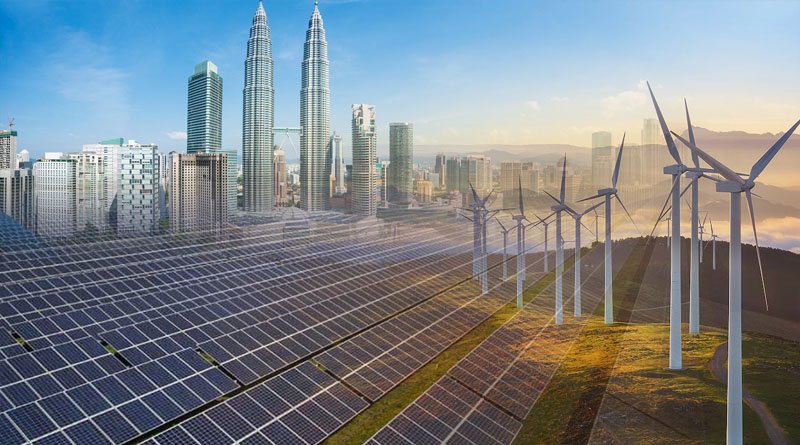According to Ko, Malaysia is regarded as being about average in Southeast Asia, and its efforts in the field of renewable energy have seen “steady growth but not super fast.”

The documentary “An Inconvenient Truth,” which won the 2006 Oscar for best documentary, and lectures from his university in Malaysia first stoked Chuan Zhen Ko’s passion for renewable energy and climate change.
Ko, who is now 39, started working on green projects in a dozen different countries before moving back to the capital of Malaysia, Kuala Lumpur. Ko began his career in the renewables sector about 15 years ago.
He co-founded Plus Xnergy, a company that helps homes, businesses, and buildings develop their own solar power systems or source clean energy supplies from elsewhere.
He has worked with IKEA, logistics giant DHL, and entertainment conglomerate Sony, and has developed six solar farms across Malaysia. He believes the level of awareness about renewable energy is the highest he has known.
Ko and other energy experts cautioned that, despite this, Malaysia is lagging behind its Southeast Asian neighbours in expanding clean energy because of a lack of financial incentives and investment, as well as red tape, which prevents the country from completing the large-scale projects necessary for it to meet its ambitious climate goals.
According to Ko, Malaysia is regarded as being about average in Southeast Asia, and its efforts in the field of renewable energy have seen “steady growth but not super fast.”
Like many countries in the region, Malaysia is regularly hit by the impacts of extreme weather and rising temperatures—whether choking haze linked to regional forest fires, water shortages, droughts, or severe floods.
Retiring modern or relatively new coal capacity is a very expensive business—because who is going to pay for it? The way that gets managed is not only through Malaysia but also through international assistance and support, and that conversation has begun.
Flooding that began in late 2021 caused nearly US$1.5 billion in losses and displaced more than 120,000 people, for example. In that same year, to help tackle climate change, Malaysia, which has pledged to cut its planet-heating emissions to net zero by 2050, set goals to source 31 percent of its power capacity from renewables by 2025 and 40 percent by 2035.
Then, last September, the previous government published a policy targeting a 17 percent share for renewables in the total national energy supply by 2040.
But with renewables today accounting for only about 9 percent of Malaysia’s electricity generation capacity, the government targets seem “highly unrealistic,” said Attaurrahman Ojindaram Saibasan, a power analyst at data company GlobalData.
Malaysia lacks “strong” renewable energy policies, said Saibasan, whose firm published a report on Malaysia’s power sector last week.
“There are no incentives offered to large-scale renewables,” he said, adding that climate-heating coal and natural gas currently make up about 75 percent of Malaysia’s power capacity mix.
Despite expensive and deadly climate impacts and lofty clean energy targets, environmental issues did not feature in last year’s election, which was dominated by the economy and cost of living. Malaysia trails Indonesia, the Philippines, Thailand, and Vietnam in renewable power generation, said Saibasan.
The government has struggled to attract investment in large-scale renewable energy projects due to a “sluggish economy” and a lack of “robust policies” to make clean power more attractive than fossil fuels, he added.
Malaysia has previously provided incentives to invest in solar, which has the greatest potential, experts say. Other promising options for Malaysia are bioenergy sourced from the palm oil industry and hydropower.
But while policy encouraged the initial take-up of solar, larger investments will be needed towards the end of this decade to modernize the power grid, boost energy storage, and support larger-scale renewables, said Joel Kwong, a partner at Boston Consulting Group in Kuala Lumpur.
Those measures are needed because the best areas to generate solar power are in the north, while demand is concentrated further south in the industrial Klang Valley, which includes the capital Kuala Lumpur, he added.
Sabah and Sarawak states on Borneo island would benefit from greater freedom to develop their own renewable power projects, experts said. Malaysia’s 2050 zero-emissions goal is a “significant signal of intention” for a developing Southeast Asian country, but consistent, longer-term plans to aid the expansion of renewables are needed to reach that and other targets.
In recent months, Indonesia and Vietnam have clinched big finance deals with rich nations to shutter coal-fired power plants early and reduce greenhouse gas emissions from their power sectors. Malaysia’s energy ministry did not respond to requests for comment.
Malaysia is largely reliant on Indonesia and Australia for its coal supplies. Peter Godfrey, managing director for Asia Pacific at the Energy Institute in Singapore, said he expects Malaysia to discuss a similar energy transition deal with donors to accelerate coal power closures.
“Retiring modern or relatively new coal capacity is a very expensive business, because who is going to pay for it?” he said.
“The way that gets managed is not only through Malaysia but also through international assistance and support, and that conversation has begun,” he added.
However, Malaysia’s abundant natural gas supplies mean there is little urgency to meet renewable energy targets, he warned, underscoring the importance of efforts to reduce emissions from the natural gas industry.
Solar entrepreneur Ko is optimistic about Malaysia’s green energy outlook, citing rising costs for labor, raw materials, and energy as a reason to switch to solar. He also called on banks to offer favorable lending rates to companies seeking to adopt cleaner energy and for local players and local governments to use trial and error to improve policies, quality of work, and technologies. He believes that renewable energy can gradually grow.
Originally published at EcoBusiness